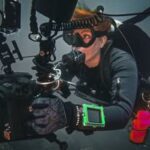Last Updated on October 8, 2024 by Candice Landau
This article is part of a larger series on scuba diving tips for beginners. It’s a product of hard-earned knowledge as a result of the many years I spent taking courses, assisting dive instructors and teaching scuba diving myself. If you’re a new diver and have concerns, please contact me. I’m happy to help, or to answer your question in an article on my site. In the meantime, happy reading—I hope this helps!
Other tips for beginners include:
- Embrace the unknown (the why and how)
As a PADI instructor, I can confidently tell you that mask skills are the ones new divers are either most nervous about, or that they struggle most with. It’s both logical and perplexing.
On the one hand, it makes sense to NOT want to flood or remove the thing that allows you to feel you have a grasp on the underwater world (sight). On the other hand, it’s a super simple skill if you are already comfortable in the water and know how to have your face underwater without inhaling water through your nose.
If you struggle with this last point, I encourage you to buy your mask well in advance of your dive class, go to a swimming pool, or even lie in the bathtub and practice being submerged without pinching your nose. Also, practice keeping your eyes underwater closed without a mask on.
If you wear contact lenses, close your eyes. If you don’t, I still recommend closing your eyes—you’ll want to get used to doing this for when you flood/clear your mask in the ocean. No thank you to getting salty water in my eyes!
The key to not inhaling water through your nose—without pinching it—is to maintain pressure in your nasal cavity. But, how do you do this? It’s a little art and a little science which is why scuba instructors are often so bad at explaining it.
You can actually practice this on dry land to begin with.
For starters, press your chin to your neck and look down (you can do this underwater too when performing mask skills). This helps minimize inhaling water through your nasal cavity.
Now, to maintain pressure in your nasal cavity, think of blowing out through your nose, without actually doing it (or doing it very minimally). Now keep breathing through your mouth. Can you do both? Breathe through your mouth normally, without breathing through your nose at all. Once you’ve mastered that, you’re ready for in-water practice.
Clear as mud? Well, what did I say about it being an art and a science. Practice practice practice.
>> Related Reading: Practice Makes Perfect
The five mask skills you’ll be asked to perform over the course of your training dives include:
- A partial mask flood and clear.
- A full mask flood and clear.
- A mask remove and replace.
- No mask breathing.
- No mask breathing swim with a buddy guiding you.
I’m not going to teach you how to clear your mask in this article—you can read my article here, if you want to know more about that—but know that this is a skill that really will become second nature if you keep diving. It’s a really good one to know as you’ll be able to use it not only to empty water from a leaking mask, but to flood your mask and clear it if it fogs up.
By mastering this technique, you’ll find that you can focus more on the wonders around you rather than worrying about your mask and the potential of it flooding. With practice, clearing your mask will become second nature, allowing you to enjoy your dives to the fullest.


















